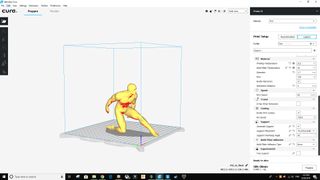Ultimaker Cura vs. Simplify 3D: Which slicer should you use for 3D printing?
We're a virtual company made up of tech experts from across the globe and we love 3D printing. We have been using as many slicers as possible over the last three years to help you choose the best one for you

Open source and free
Ulitimaker Cura is a powerful, open source slicer, suitable for any hobbyist or newcomer to 3D printing but still needs to work on advanced settings like supports.
For
- Free.
- Fast paced update schedule.
- Open Source.
Against
- Behind the times on some settings.
- Slow to process models.

Powerful and Profesional
With its multiple process system and custom profiles, Simplify 3D is the very best in slicing technology, but the price may be too high for some.
For
- Multiple process system.
- Easy to import profiles for different printers.
- Customizable support structures.
Against
- Expensive for hobbyists.
- Update cycle is slow.
Both Cura and Simplify 3D have the same slicing capabilities. They will both slice all three of the major formats and Simplify 3D also allows you to output X3G files for printers like the replicator series. Cura, however, requires an add-on to make X3G work.
| Header Cell - Column 0 | Ultimaker Cura | Simplify 3D |
|---|---|---|
| Import and export profiles | ❌ | ✔️ |
| Multiple printer compatability | ✔️ | ✔️ |
| Customizable supports | ❌ | ✔️ |
| Virtual print simulation | ✔️ | ✔️ |
| Editable layer processes | ❌ | ✔️ |
| STL, OBJ, 3MF support | ✔️ | ✔️ |
| X3G output support | ✔️ (add-on required) | ✔️ |
What Cura does well

Cura is a constantly evolving platform that learns from its mistakes and improves on an almost weekly basis. There is granular control over almost any setting you could want from the big stuff like layer height, down to the minutiae of initial layer travel acceleration — a setting so detailed nobody needs to change it ever — which allows anyone, casual users or hardcore 3D print enthusiasts to get the most out of it.
Open source software is crucial in the early days of an emerging market like 3D printing and Cura helps pave the way to make 3D printing accessible to as many people as possible while still offering a quality piece of software. Even large companies like LulzBot use the source code of Cura to build their branded software for the Taz and Mini printers they sell. When you add the fact that it is free to the mix and you have a lot of powerful reasons why you should Cura
What Cura doesn't do well
While Cura is usually good at slicing models for print, but one area it lacks in is support control. Cura has historically been very bad at support settings, and I would know — I've spent hours trying to get the perfect supports only to fail time and again.
This is something it's have been working on with the introduction of tree supports — smaller supports that branch off of each other to reduce contact points — and with the new support blocker it's getting closer but it still extremely difficult to get a good setting.
The only other big problem with Cura is the processing speed. When slicing the same model with the same settings, Cura took twice as long to slice than Simplify 3D — 19 seconds instead of eight for this particular model — and that gap increases with more complex meshes or settings. On slower machines, it's common to get freezes or hang-ups that require restarting Cura.
What Simplify 3D does well

Simplify 3D is all about options and saving those options to use later. Using a system of profiles and processes, Simplify 3D allows you to make specific settings for different printers, filaments, and even models, then quickly and easily store them for later use. These profiles can also be exported and imported from other people, allowing the community to share best practices with each other in a way that's just not possible with Cura.
Get the Windows Central Newsletter
All the latest news, reviews, and guides for Windows and Xbox diehards.
Processes on their own are extremely helpful when printing complex models. You can use them to adjust settings on a per layer basis such as temperature, infill percentage, and even layer height to maximize your print quality and minimize your print time. I use it often to reduce the infill in larger areas of the model to help speed my prints up and it works great.
While Cura struggles to produce good support structures Simplify 3D creates masterpieces. Using a completely customizable support system — you can change the thickness of the supports as well as add or remove them manually — Simplify 3D makes sure your models are always scar free and look their very best. I am always impressed when I print the same model in both Cura and Simplify 3D and I have to carve out the supports from the Cura model while the Simplify 3D supports just peel away. It's almost worth the $150 just for the supports.
What Simplify 3D doesn't do well
Simplify 3D has one of the slowest update cycles I have ever seen in a piece of software. It took over a year for S3D to go from version 3.1 to version 4 and in the fast-paced world of 3D printing, a year may as well be a decade.
This October, there's supposed to be a new update and hopefully, it will mark a quicker update cycle, but as of right now Simplify 3D lags behind in terms of new ways to print.
Which do you choose?
If you are a hobbyist, trying to get into 3D printing, or spending as little as you can right now then Cura is the right choice for you. As far as free software goes it beats everything else available by a long way.

A powerful, open source slicer for the hobbyist
While Cura suffers from slow processing times, it's open nature and rapid update cycle make it an excellent free choice.
If you're looking to make money from your prints then Simplify 3D is the way to go. Yes, it's $149 and the update cycle is slow, but it gives the best print quality as well as the most printer support and customization that you can ask for in a slicer.
James built his first PC when he was 13 and has never looked back. He can be found on Windows Central, usually in the corner where all the 3D printers are, or huddled around the Xbox playing the latest games.
